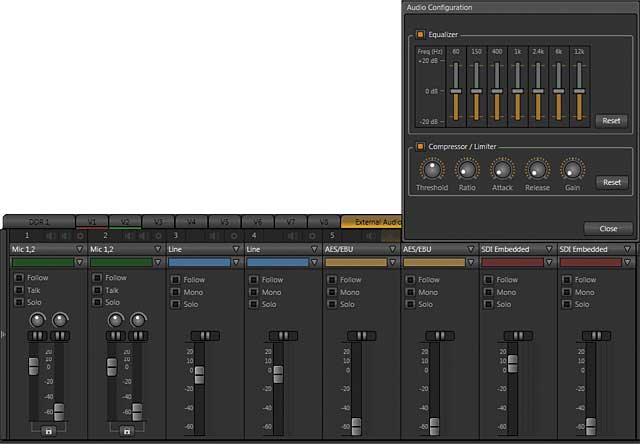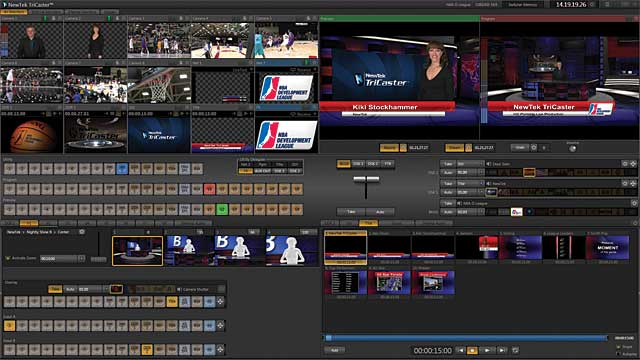Review: NewTek TriCaster TCXD850 Extreme
Speaking of recordings, TCDX850X is capable of full HD (1080p30) recording of any input as well as the program or AUX outputs, simultaneously recording an output along isolation recording of up to eight simultaneous camera inputs with its proprietary IsoCorder software.
This feature can’t be overemphasized. During a live video production session, the TCXD850X can stream, send a video mix to large screens in a local facility (often called IMAG), and record an AVI, MPEG-2, or QuickTime version of every camera as well as the master (program) output. This feature is ideal for those who might want to dedicate a single camera to a particular sports player or stage actor. NewTek includes an editing tool to replace shots or trim content, providing the director or producer peace of mind during a live production, with the knowledge that they can do a bit of postproduction magic on the on-demand version using the IsoCorder isolated camera recordings.
Inputs and Outputs
TCXD850X has a plethora of inputs and outputs. Ranging from AES audio to multiple analog and digital video options, the TCXD850X has an input option for almost every use-case scenario.
VIDEO
Each of the eight video inputs has three BNC connectors to allow the choice of Component, Composite, Y/C, or SDI inputs. Given the number of BNC connectors on the back of the TriCaster, an included BNC insertion tool is a welcome and thoughtful addition for those of us with oversized fingers or a fear of small places. TCXD850X uses 4:4:4:4 video processing and 32-bit Floating Point processor functionality on all eight simultaneous video inputs. TriCaster can use any combination of HD-SDI, HD Component, SD-SDI, SD Component, Y/C (BNC), or Composite. SMPTE specifications include SMPTE 292M (HD-SDI) and SMPTE 259M/ITU-R BT.656 (SD-SDI).

NewTek's IsoCorder technology allows up to eight discrete camera signals to be simultaneously recorded.
With the combination of two DDRs as well as two network inputs, titling, and stills, the TCXD850X is capable of mixing 22 video inputs, including eight virtual inputs that are part of the virtual sets NewTek provides.
AUDIO
A series of Cannon 3-pin (XLR) connectors provide analog audio inputs (eight) and outputs (four), and an additional grouping of eight XLR connectors provide AES audio inputs/outputs via two digital stereo pairs per XLR connector. Eight SDI connectors, used exclusively for audio, also provide embedded audio in stereo pairs, with four SDI connectors used to output audio in eight channels (four stereo pairs).
Audio is set at a constant frequency and bit depth (24 bits, 48 kHz) with no ability to go up (for 24/96 kHz recordings) or down (for 16/44.1 kHz recordings); 48 kHz is a good common ground, but with 24-bit recording functionality for a studio- based product, it would be nice to see a 96-kHz option.
DVI AND HDMI
The TCXD850X sports two DVI connectors, one for program and another for multiview, preview, or auxiliary (AUX) outputs. These two DVI connectors can be concfverted to HDMI or VGA, thanks to the fact that the DVI connectors are DVI-I, or integrated analog and digital connectors. The two DVI connectors, while marked as Program and AUX respectively, can actually be used for either type of output view.
In our testing, we ran into an issue when we disconnected one monitor during an active session. Doing so caused the other monitor we were using to incorrectly display a screen view not intended for it; the TriCaster had attempted to push the primary screen to what had been the secondary monitor. Reconnecting the first monitor failed to revert the screens to their previously selected outputs. NewTek is aware of this problem, notes that it may involve an EDID monitor identification mismatch, and is seeking a solution to the replicable problem. It’s safe to say that monitors should only be disconnected while in Windows administrative mode or after the TriCaster has been shut down.
Streaming and Transcoding
In our testing, we simultaneously recorded and streamed a live event. We then used the transcoding features in postproduction, in order to convert the recorded version to a variety of on-demand formats.
STREAMING
NewTek takes an approach on the TCXD850X that is a welcome departure from the average integrated encoding solution. While recording settings prompt for choosdzving AVI, H.264, MPEG-2, or QuickTime, the streaming settings prompt by content delivery network (CDN). When one configures the streaming connection for a TriCaster session, the options include shortcut links to a variety of CDNs and online video platforms, including Akamai, BitGravity, Brightcove, Livestream, The Sermon Network (for houses of worship), Ustream, and YouTube.

TriCaster’s Streaming Profile Manager contains a number of predefined shortcuts for popular CDNs and online video platforms.
Once the settings are established, the TriCaster user can choose to set audio head- room at a range from +6 to +20 db and can then test the connection. The TCXD850X is capable of 16:9 streaming, up to 720p, using either Adobe Flash or Windows Media Push/Pull. Streaming can be performed with the H.264 codec, and NewTek also includes VC-1 codec support.
TRANSCODING
NewTek has eliminated the need to transcode on ingest for use on the two DDRs in live production, as most major formats are recognized. For postproduction work, such as editing on NewTek’s included nonlinear editing (NLE) tool, there is a need to transcode content. To prepare content for editing that’s been recorded on a non-TriCaster system, a clip must be transcoded into SpeedHQ-recognized video formats (the video format that TriCaster prefers and on which the SpeedEDIT NLE tool is based).
The included transcoding tool is also handy for converting TriCaster recordings to multiple on-demand streaming formats. TCXD850X uses the core FFmpeg engine, an open source transcoding engine. While FFmpeg is not yet multithreaded (which means that the TCXD850X cannot take advantage of all cores to accelerate a single transcoding of a single file), it is possible to do multiple transcodes simultaneously using one processor core per transcoding session. Since the TCXD850X has eight cores to work with, up to eight transcoding instances could occur simultaneously.
Pricing
Current pricing between the TriCaster TCXD850 and TCXD850X has a delta of $10,000, with the TCXD850 priced at $24,995 and the TCXD850X priced at $34,995. The TCXD80 CS (control surface) runs $5,995, but we’ve seen special bundles that drop several thousand dollars off the combined cost of the unit and control surface.
There’s also good news for most TCXD850 users who want to upgrade to the Extreme version: The underlying Windows-based system for the TCXD850 and TCXD850X are now the same physical unit with the same processors. When the Extreme version began shipping in June 2011, NewTek quietly began shipping Extreme-capable TriCaster 850 units that took advantage of the Sandy Bridge bus architecture and graphics enhancements.
This future-proofing approach allows TCXD850-to-TCXD850X upgrades to be performed more quickly in the field as a software upgrade, rather than requiring the more labor-intensive “send-it-back-to-NewTek” hardware upgrade that the original TCXD850 units required. Kudos to NewTek for keeping the customer’s long-term expansion goals in mind.
Related Articles
The first plugin to use the TriCaster SDK, Livestream offers one-click high-def encoding.
31 Jan 2012
NewTek TriCaster TCXD850 CS provides a physical connection including a three-axis joystick controller
17 Feb 2011